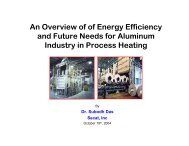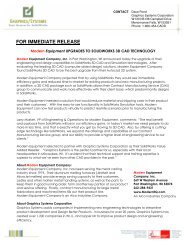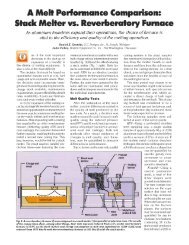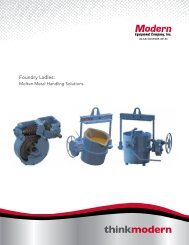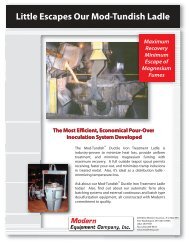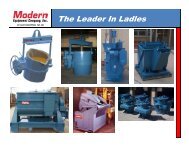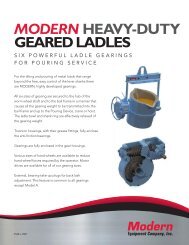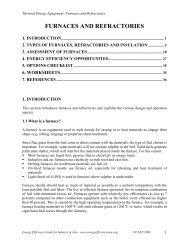ITP Metal Casting: Advanced Melting Technologies: Energy Saving ...
ITP Metal Casting: Advanced Melting Technologies: Energy Saving ...
ITP Metal Casting: Advanced Melting Technologies: Energy Saving ...
You also want an ePaper? Increase the reach of your titles
YUMPU automatically turns print PDFs into web optimized ePapers that Google loves.
molten metal between furnaces or to the casting station is a critical step in the casting process<br />
that could be improved for energy efficiency. With the rising gas and electric prices, maintaining<br />
the temperature of the metal between the melting furnace and the pouring station can be<br />
expensive. If the distance between the melting room and pouring room is short or negligible,<br />
70<br />
then less heat would be needed to do so. Thus, close proximity of the furnace to the pouring<br />
location can add up to substantial annual savings and improved safety.<br />
4.4.1 Dosing Furnaces<br />
Dosing furnaces are closed holding furnaces with a<br />
spout for direct metal delivery (Exhibit 27). They are<br />
used to dispense an accurate amount of molten metal<br />
to<br />
the die casting machine or mold line. The advantage of<br />
the dosing furnace is that because of the closed<br />
structure, it minimizes heat loss and protects the molten<br />
metal from excessive oxidation. These furnaces require<br />
only about one-fifth of the energy to hold 2,000 pounds<br />
of aluminum in comparison to an open crucible furnace,<br />
and one-third of the operating costs of a comparable<br />
holding furnace. In Europe, dosing furnaces are<br />
replacing ladle furnaces in die casting because of their<br />
ability to pour accurate amount of molten metal at<br />
the<br />
right temperature. 71<br />
4.4.2 Electro-Magnetic<br />
Pump Systems<br />
Source: Case Western Reserve University<br />
Exhibit 27: Schematic of dosing<br />
furnace<br />
An electromagnetic pump (EMP) may be used to<br />
circulate hot metal through a patented scrap charging<br />
chamber (Exhibit 28).<br />
g of<br />
72 The pump circulates the<br />
molten bath in the reverberatory furnace at a maximum<br />
flow rate of approximately 10 tons/minute. Meltin<br />
metal inside wells, supplied with molten metal from<br />
electro-magnetic pumps, has become more common<br />
since the mid-1990s.<br />
EMP systems offer two opportunities to improve<br />
melting<br />
efficiency: temperature homogeneity of the<br />
melt pool and side-well melting. The melt pool in most<br />
furnaces is stagnant, which contributes to the<br />
http://www.sovereign-publications.com/emp.htm development of a vertical temperature profile in the<br />
Exhibit 28: Electro-magnetic pump<br />
pool. When the surface temperature of the molten<br />
system<br />
metal is different from the floor temperature, it creates<br />
inefficiency since radiant energy from the roof and conductive energy from the hot flue gases is<br />
being directed at the hot side of the metal pool. Stirring of the pool with electro-magnetic pumps<br />
can eliminate the vertical temperature profile, enhancing efficiency and productivity. Also EMP<br />
29



